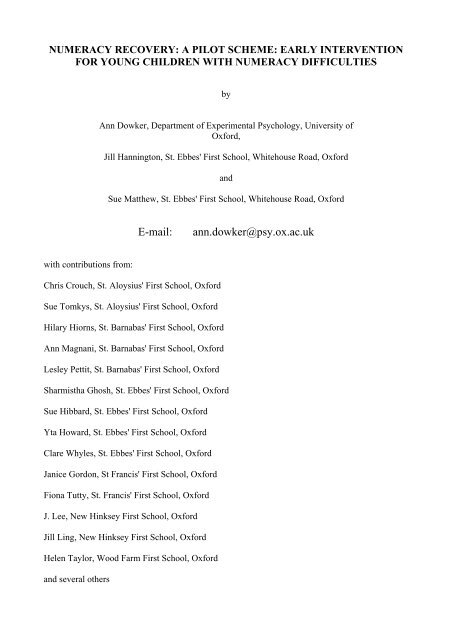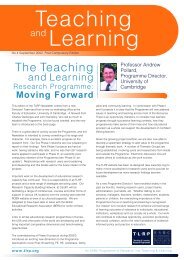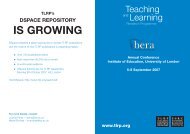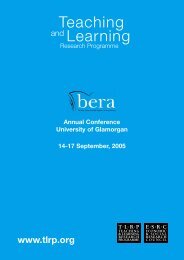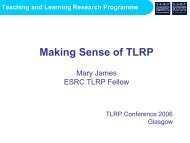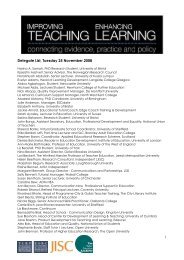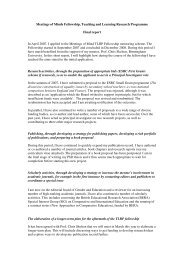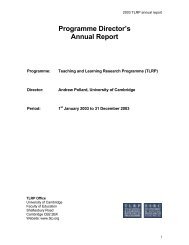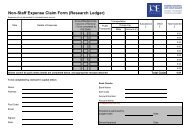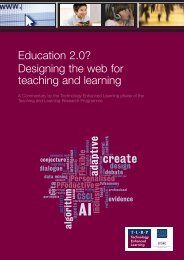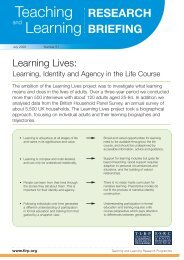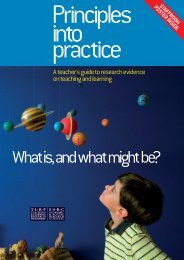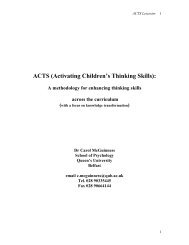NUMERACY RECOVERY: A PILOT SCHEME ... - Catch Up > Home
NUMERACY RECOVERY: A PILOT SCHEME ... - Catch Up > Home
NUMERACY RECOVERY: A PILOT SCHEME ... - Catch Up > Home
You also want an ePaper? Increase the reach of your titles
YUMPU automatically turns print PDFs into web optimized ePapers that Google loves.
<strong>NUMERACY</strong> <strong>RECOVERY</strong>: A <strong>PILOT</strong> <strong>SCHEME</strong>: EARLY INTERVENTION<br />
FOR YOUNG CHILDREN WITH <strong>NUMERACY</strong> DIFFICULTIES<br />
by<br />
Ann Dowker, Department of Experimental Psychology, University of<br />
Oxford,<br />
Jill Hannington, St. Ebbes' First School, Whitehouse Road, Oxford<br />
and<br />
Sue Matthew, St. Ebbes' First School, Whitehouse Road, Oxford<br />
E-mail:<br />
ann.dowker@psy.ox.ac.uk<br />
with contributions from:<br />
Chris Crouch, St. Aloysius' First School, Oxford<br />
Sue Tomkys, St. Aloysius' First School, Oxford<br />
Hilary Hiorns, St. Barnabas' First School, Oxford<br />
Ann Magnani, St. Barnabas' First School, Oxford<br />
Lesley Pettit, St. Barnabas' First School, Oxford<br />
Sharmistha Ghosh, St. Ebbes' First School, Oxford<br />
Sue Hibbard, St. Ebbes' First School, Oxford<br />
Yta Howard, St. Ebbes' First School, Oxford<br />
Clare Whyles, St. Ebbes' First School, Oxford<br />
Janice Gordon, St Francis' First School, Oxford<br />
Fiona Tutty, St. Francis' First School, Oxford<br />
J. Lee, New Hinksey First School, Oxford<br />
Jill Ling, New Hinksey First School, Oxford<br />
Helen Taylor, Wood Farm First School, Oxford<br />
and several others
Abstract<br />
A Numeracy Recovery scheme, funded by the Esmee Fairbairn Charitable Trust, is being piloted<br />
with 6-and 7-year-olds in six First Schools in Oxford. The scheme involves working with children<br />
who have been identified by their teachers as having problems with arithmetic. These children are<br />
assessed on eight components of early numeracy: (1) principles and procedures related to counting;<br />
(2) use of written arithmetical symbolism; (3) use of place value in arithmetic; (4) understanding<br />
and solution of word problems; (5) translation between concrete, verbal and numerical formats; (6)<br />
use of derived fact strategies for calculation; (7) arithmetical estimation and (8) memory for<br />
number facts. The children then receive weekly individual intervention in the particular<br />
components with which they have been found to have difficulty. To assess effects, children receive<br />
the WISC Arithmetic subtest the BAS Basic Number Skills subtest, and the WOND Numerical<br />
Operations test before the intervention begins, and at intervals of about 6 months. For the first 71<br />
children in the project, Wilcoxon tests showed a significant improvement in standardized scores in<br />
all tests approximately a year following the start of intervention.<br />
Numeracy recovery: a pilot scheme: Early intervention for young children with numeracy<br />
difficulties.<br />
Specific difficulties in arithmetic have rarely received the same attention as specific difficulties in<br />
reading and writing; but it is likely that a higher proportion of adults experience persistent<br />
numeracy difficulties than by persistent literacy difficulties. Numerous studies demonstrate that a<br />
significant number of people experience difficulties with arithmetic, and for instance find it<br />
difficult to carry out arithmetical tasks of a type that are important in daily life, and have negative<br />
emotional reactions to arithmetic (Hitch, 1978; Cockcroft, 1982; ALBSU 1987; Cornelius 1992).<br />
There is evidence (ALBSU 1987) that a high proportion of adults with severe numeracy difficulties<br />
had already shown signs of arithmetical difficulties in the early school years. It should be made<br />
clear at the outset that arithmetic is by no means the only important part of mathematics, or the only<br />
part that creates difficulty for some individuals. It does, however, appear to create particular anxiety<br />
for many people.<br />
In the area of reading skills, there has already been considerable emphasis on early identification of<br />
individual patterns of strengths and weaknesses, and their use in compensatory education for<br />
backward readers (e.g. Clay, 1985; Sylva and Hurry, 1995). However, there had been, especially<br />
until recently, little comparable work in the field of mathematical development and mathematics<br />
education.<br />
Some previous research (Dowker, 1995, 1998) has suggested that specific arithmetical weaknesses<br />
are quite common; and are often restricted to particular components of arithmetic (e.g. written<br />
symbolism; memory for number facts; estimation). These findings have led to consideration of the<br />
desirability of a Numeracy Recovery scheme for assessing and ameliorating children's difficulties<br />
with specific areas of arithmetic in the early primary school years: before children have developed<br />
inappropriate arithmetical strategies based on fundamental misunderstandings, and/or developed<br />
negative or even phobic reactions to arithmetic.<br />
While many forms of extra one-to-one teaching are likely to be helpful to children with difficulties,<br />
techniques that are targeted toward an individual child's specific weaknesses would seem likely to<br />
be most effective.
Current project<br />
Such a Numeracy Recovery scheme is being piloted with 6-and 7-year-olds (mostly Year 2) in<br />
some First Schools in Oxford. It is currently being funded by the Esmee Fairbairn Charitable Trust.<br />
The scheme involves working with children who have been identified by their teachers as having<br />
problems with arithmetic. These children are assessed on eight components of early numeracy,<br />
which are summarized and described below. The children then receive weekly individual<br />
intervention (half an hour a week) in the particular components with which they have been found to<br />
have difficulty. The interventions are be carried out by the classroom teachers, using techniques<br />
proposed by myself. The teachers are released (each teacher for half a day weekly) for the<br />
intervention, by the employment of supply teachers for classroom teaching. Each child remains in<br />
the program for 30 weeks, or until their teachers feel they no longer need intervention; whichever is<br />
shorter. New children join the project periodically.<br />
The project has been set up in six Oxford primary schools. Some schools began intervention work<br />
in the autumn term of 1998; others were delayed in starting as a result of OFSTEDs and SATs, and<br />
resulting pressures on the teachers. However, the project is now well underway in all six schools.<br />
78 children (about 15% of the children in the relevant classes) have so far begun or<br />
undergone intervention,<br />
Components that are the focus of the project<br />
The components addressed here are not to be regarded as an all-inclusive list of components of<br />
arithmetic, either from a mathematical or educational point of view. Rather, a few components have<br />
been selected because discussion with teachers has indicated to be important in early arithmetical<br />
development, and because research (Dowker, 1995; Dowker, 1998) has shown to vary considerably<br />
between individual children in the early years.<br />
The components that are the focus of the project include (1) principles and procedures related to<br />
basic counting; (2) use of written arithmetical symbolism; (3) use of place value in arithmetic; (4)<br />
understanding and solution of word problems; (5) translation between concrete, verbal and<br />
numerical formats; (6) use of derived fact strategies for calculation; (7) arithmetical estimation and<br />
(8) memory for number facts.<br />
Remediation for these components principally involves techniques devised by the author,<br />
supplemented by exercises and games taken from published materials (e.g. Burgess, 1995 a, b;<br />
Long, 1996; Preston, 1998 Scarry, 1998; Straker, 1996 Techniques devised and used by the<br />
teachers themselves also play a major role in the project.<br />
The components, and the main intervention techniques, will now be summarized:<br />
(1) Pinciples and procedures related to counting:<br />
This component includes accurate counting of sets of objects; rote verbal counting;<br />
understanding of some of the principles involved in counting (Greeno, Riley and Gelman,<br />
1984); and repeated addition and subtraction by 1. Very basic counting rarely presents<br />
problems for 6-year-olds, even those who are weak at arithmetic. The areas that are most<br />
likely to present difficulties for children in this age group are:
(a)<br />
Understanding of the order-irrelevance principle. In other words, the child needs to<br />
be able to understand that the result of counting a set of items will not change if the<br />
items are counted in a different order, whereas adding or subtracting an item will<br />
change the number.<br />
(b)<br />
Repeated addition by 1, where children counts a set of 8 counters, and are asked how<br />
many there will be if one more counter is added. This is repeated up to 20.<br />
(c)<br />
Repeated subtraction by 1, where children count a set of 10 counters, and are asked<br />
how many there will be if one is taken away. This is repeated down to zero.<br />
Intervention:<br />
For the order irrelevance principle, children practice counting and answering cardinality and<br />
order-irrelevance questions about very small numbers of counters (up to 4); and are then<br />
given further practice with increasingly large sets. For repeated addition by 1 and repeated<br />
subtraction by 1, children are given practice in observing and redicting the results of such<br />
repeated additions and subtractions with counters (up to 20). They will then be given verbal<br />
'number after' and 'number before' problems: "What is the number before 8?", "What is the<br />
number after 14?", etc.<br />
(2) Written symbolism for numbers<br />
There is much evidence that children often experience difficulties with written arithmetical<br />
symbolism of all sorts, and in particular with representing quantities as numerals (Ginsburg,<br />
1989; Fuson, 1992). With regard to this component, children are asked to read aloud a set of<br />
single-digit and two-digit numbers. A similar set of numbers is dictated to them for writing.<br />
Intervention: Children practice reading and writing numbers. Children with difficulties in<br />
reading or writing two-digit numbers (tens and units) are given practice in sorting objects<br />
into groups of ten, and recording them as "20", "30", etc. They will then be given such<br />
sorting and recording tasks where there are extra units as well as the groups of ten.<br />
(3) Understanding the role of place value in number operations and arithmetic<br />
This involves the ability to add 10s to units (20 + 3 = 23); the ability to add 10s to 10s (20 +<br />
30 = 50); and the ability to combine the two into one operation (20 + 33 = 53). A related<br />
task involves pointing to the larger number in pairs of 2-digit numbers, that vary either just<br />
with regard to the units (e.g. 23 versus 26)"; just with regard to the 10s (e.g. 41 versus<br />
51); or where both tens and units vary in conflicting directions (e.g. 27 versus 31; 52 versus<br />
48).
Intervention:<br />
Children are shown the addition of tens to units and the addition of tens to tens in several<br />
different forms:<br />
(i)<br />
(ii)<br />
(iii)<br />
(iv)<br />
(v)<br />
Written numerals;<br />
Number line or number block;<br />
Hands and fingers in pictures;<br />
10-pence pieces and pennies;<br />
Any apparatus (e.g. Multilink or Unifix) with which the child is familiar. The fact<br />
that these give the same answers should be emphasized. Children whose difficulties<br />
are more specific to the use of place value in arithmetic may be given practice with<br />
arithmetical patterns such as: "20 + 10; 20 + 11; 20 + 12", etc; being encouraged to<br />
use apparatus when necessary.<br />
(4) Word problem solving<br />
This component involves comprehending addition and subtraction story problems of various<br />
semantic types (see DeCorte and Verschaffel, 1987); selecting the appropriate operations;<br />
and solving the problems.<br />
Intervention<br />
Children are given addition and subtraction word problems, which are discussed with them:<br />
"What are the numbers that we have to work with?" "What do we have to do with the<br />
numbers?" "Do you think that we have to do an adding sum or a taking-away sum?" "Do<br />
you think that John has more sweets or fewer sweets than he used to have?", etc. They are<br />
encouraged to use counters to represent the operations in the word problems, as well as<br />
writing the sums numerically.<br />
(5) Translation between arithmetical problems presented in concrete, verbal and numerical<br />
formats<br />
Translation between concrete, verbal and numerical formats has been suggested by several<br />
people to be a crucial area of difficulty in children's arithmetical development. For example,<br />
Hughes (1986) reported that many primary school children demonstrate difficulty in<br />
translating between concrete and numerical formats (in either direction), even when they are<br />
reasonably proficient at doing sums in either one of these formats and has suggested that<br />
this difficulty in translation may be an important hindrance to children's understanding of<br />
arithmetic.<br />
The current project includes tasks of translating in all possible directions between numerical<br />
(written sums); concret (operations with counters); and verbal (word problem) formats for<br />
both addition and subtraction.
For example, in translating from verbal to numerical, they are presented with word<br />
problems, children are presented with word problems (e.g. 'Katie had five apples; she ate<br />
two, so now she has three left), and are asked to "write down the sum that goes with the<br />
story"<br />
Intervention<br />
Children are shown the same problems in different forms, and shown that they give the<br />
same results. They are also encouraged to represent word problems and concrete problems<br />
by numerical sums, and to represent numerical problems and word problems by concrete<br />
objects.<br />
(6) Derived fact strategies in addition and subtraction<br />
One crucial aspect of arithmetical reasoning is the ability to derive and predict unknown<br />
arithmetical facts from known facts, for example by using arithmetical principles such as<br />
commutativity, associativity, the addition/ subtraction inverse principle, etc.<br />
Children are given the Addition and Subtraction Principles Test developed by Dowker<br />
(1995, 1998). In this test, they aregiven the answer to a problem and then asked them to<br />
solve another problem that could be solved quickly by the appropriate use of an arithmetical<br />
principle (e.g. they may be shown the sum "23 + 44 = 67" and then asked to do the sum 23<br />
+ 45, or 44 + 23). Problems preceded by answers to numerically unrelated problems are<br />
given as controls. The children are asked whether "the top sum" helps them to do "the<br />
bottom sum", and why. The actual addition and subtraction problems involved will vary in<br />
difficulty, ranging from those which the child can readily calculate mentally, through those<br />
just beyond the child's calculation capacity, to those very much too difficult for the child to<br />
solve. The particular derived fact strategies that are the main focus of this project are those<br />
involving commutativity (e.g. if 8 + 6 = 14, then 6 + 8 = 14); the associativity-based N + 1<br />
principle (if 9 + 4 = 14, then 9 + 5 = 14 + 1 = 15) and the n - 1 principle (e.g.t if 9 + 4 = 13,<br />
then 9 + 3 = 13 - 1 = 12).<br />
Intervention:<br />
Children are presented with pairs of arithmetic problems . The 'derived fact strategy'<br />
techniques are pointed out and explained to them; and they are invited to solve similar<br />
problem. If they fail to do so, the strategies are demonstrated to them for single-digit<br />
addition and subtraction problems, with the help of manipulable objects, and of a number<br />
line; and will again be invited to carry out other derived fact strategy problems.
(7) Arithmetical estimation<br />
The ability to estimate an approximate answer to an arithmetic problem, and to evaluate the<br />
reasonableness of an arithmetical estimate, are important aspects of arithmetical<br />
understanding. In assessing and remediating this component, children are given a task<br />
devised by the author (Dowker, 1996). They are presented with a series of problems of<br />
varying degrees of difficulty, and with estimates made for these problems by imaginary<br />
characters (Tom and Mary). The children are asked (a) to evaluate "Tom and Mary"'s<br />
estimates on a five-point scale from "Very good" to "Very silly"; and (b) to suggest "good<br />
guesses" for these problems themselves. Once again, the actual addition and subtraction<br />
problems involved vary in difficulty, ranging where possible from those which the child can<br />
readily calculate mentally, through those just beyond the child's calculation capacity, to<br />
those very much too difficult for the child to solve.<br />
Intervention:<br />
Children are shown other arithmetical estimates by "Tom and Mary" and asked to evaluate<br />
them. They are encouraged to give reasons for their evaluations.<br />
(8) Number fact retrieval<br />
Although most psychologists, educators and mathematicians agree that memorization of<br />
facts is not the essence of arithmetic, knowledge of number facts does contribute to<br />
efficiency in calculation (cf. Merttens, 1996), and is a significant factor in distinguishing<br />
between mathematically normal and mathematically 'disabled' children (Russell and<br />
Ginsburg, 1982). In this study, this skill is principally assessed through Russell and<br />
Ginsburg's (1982) Number Facts Test.<br />
Intervention:<br />
Children are presented with some of the basic addition and subtraction facts (e.g. 3 + 3 = 6;<br />
6 + 6 = 12). They are presented with the same sums repeatedly in the same session and in<br />
succesive sessions. They also play 'number games' (e.g. some from X) that reinforce number<br />
fact knowledge.<br />
Evaluation of effectiveness: some preliminary results<br />
The children in the project, together with some of their classmates and children from other<br />
schools, are given three standardized arithmetic tests: the British Abilities Scales Basic<br />
Number Skills subtest (1995 revision), the WOND Numerical Operations test, and the<br />
WISC Arithmetic subtest. The first two greatest emphasis on computation abilities and the<br />
latter on arithmetical reasoning. The children are retested at intervals of approximately six<br />
months.<br />
The project and its evaluation are still in relatively early stages. However, the initial, 6-<br />
month and 1-year standardized test scores of the first 71 children to take part in the project<br />
have now been analyzed. Not all of the data from 'control' children are yet available, but the<br />
tests are standardized, so it is possible to estimate the extent to which children are or are not<br />
improving relative to others of their age in the general population.
Results so far have been very promising. The median standard scores on the BAS Basic<br />
Number Skills subtest were 94 initially and 100 after one year. The median standard scores<br />
on the WOND Numerical Operations test were 88.5 initially and 91 after one year. The<br />
median standard scores on the WISC Arithmetic subtest were 6 initially, and 8 after one<br />
year. Wilcoxon tests showed that the improvements on the BAS Basic Number Skills<br />
subtest (W = 589) and WISC Arithmetic subtest (W = 266) were significant at the 0.01<br />
level, and that the improvement on the WOND Numerical Operations subtest (W = 794)<br />
was significant at the 0.05 level.<br />
The retesting and evaluation is intended to be carried out over a period of at least 3 years to<br />
assess whether gains made in the project are preserved in the longer term. A long-term goal<br />
is to compare the effects of this project with those of other intervention techniques, and of<br />
individual attention as such, so as to assess its specific effectiveness.<br />
Teacher's comments:<br />
The reactions of the teachers in the schools concerned have been very positive. They have<br />
expressed enthusiasm over the chance to work with children on an individual basis, and feel that the<br />
children are enjoying the project and are making considerable improvements. Some of them have<br />
said that involvement in the project is also giving them good ideas for general classroom arithmetic<br />
teaching.<br />
A few of their comments may serve as an an appropriate tentative conclusion at this stage:<br />
'The children are responding very well to the materials and to the extra support... They are working<br />
through activiites linked to basic number skills to establish and reinforce early concepts. Feedback<br />
from staff, children and parents has been very positive."<br />
'(The project) has given us valuable information about pupils' learning needs in a core subject, and<br />
has provided us with the funding to support the most needy children with individual tuition... As a<br />
consequence, we have seen the targeted pupils improve considerably in competence and<br />
confidence.'<br />
'Working with children individually gives greater opportunity for analysing their thinking through<br />
individual questioning... There is more time and opportunity for using apparatus and asking<br />
children to demonstrate what they are doing. These children are often very reluctant to verbalise<br />
what they are thinking and in a whole class or even small group situation, there is not the time to<br />
wait for or expect their replies. By giving the children 'thinking time', their confidence and<br />
willingness to 'have a go' develops as they offer explanations...The children seem to enjoy coming<br />
to the sessions and it has been possible to raise their self-esteem in mathematics in most cases.'<br />
Several teachers considered that this individualized work complemented the classroom-based<br />
Numeracy Hour well, to provide a particularly effective combination.
General implications for transformation of learning<br />
There are several implications for effective transformation of arithmetical (and possibly other)<br />
learning more generally:<br />
(1) Individualized work with children who are falling behind in arithmetic has a significant<br />
impact on their performance. The amount of time given to such individualized work does<br />
not, in many cases, need to be very large to be effective: these children received<br />
approximately half an hour a week, and showed considerable benefits.<br />
(2) Children are rarely uniformly weak at all aspects of arithmetic. It is misleading and<br />
potentially damaging to describe a child as globally 'good' or 'bad' at arithmetic. Although<br />
future research will be needed to compare the effectiveness of different types of program, it<br />
appears that diagnosis of, and intervention, in the specific areas of children's weaknesses is<br />
likely to prove particularly effective.<br />
(3) The study strongly supports the view that children's arithmetical difficulties are highly<br />
susceptible to intervention. It is not the case that a large number of children are simply 'bad<br />
at maths'. It is particularly notable that some of the greatest improvement occurred in the<br />
WISC Arithmetic subtest: a test sometimes regarded as a measure of predominantly<br />
'innate'intelligence.<br />
(4) Collaborations between teachers and researchers are desirable in addressing educational<br />
problems.
References<br />
ALBSU (1992). Literacy, numeracy and adults: evidence from the<br />
National Child Development Study. London: Adult Literacy and<br />
Basic Skills Unit.<br />
BURGESS, L. (1995a). Counting: key skills in maths for ages 5 to<br />
7. Oxford: Heinemann.<br />
BURGESS, L. (1995b). Pattern: key skills in maths for ages 5 to<br />
7. Oxford: Heinemann.<br />
CLAY, M. M. (1985). The early detection of reading difficulties:<br />
a diagnostic survey with recovery procedures, 3rd edition.<br />
Auckland,<br />
N.Z.: Heinemann.<br />
COCKCROFT, W.H. (1982). Mathematics counts. London: HMSO.<br />
CORNELIUS, M. (1992). The numeracy needs of graduates in<br />
employment. University of Durham, unpublished manuscript.<br />
DECORTE, E. and VERSCHAFFEL, L. (1987). The effect of semantic<br />
structure on first-graders' strategies for solving addition<br />
and subtraction word problems. Journal for Research in<br />
Mathematics Education, 18, 363-381<br />
DOWKER, A.D. (1995). Children with specific calculation<br />
difficulties. Links 2, 2, 7-11.<br />
DOWKER, A. (1996). Arithmetical estimation: when does it begin?<br />
Poster presented at British Psychological Society<br />
Developmental Section Conference, Oxford, September 11th-12th,<br />
1996.<br />
DOWKER, A. (1998). Individual differences in arithmetical<br />
development. In C. Donlan (ed.):The development of mathematical<br />
thinking. London: Taylor and Francis.<br />
FUSON, K. (1992). Research on learning and teaching addition and<br />
subtraction of whole numbers. In: G. Leinhardt, R. Putnam<br />
and R.A. Hattrop (eds.) Analysis of arithmetic for mathematics<br />
teaching. Hillsdale, N.J.: Erlbaum.<br />
GINSBURG, H.P. (1989). Children's arithmetic. New York, N.Y.: Van<br />
Norstrand.<br />
GREENO, T.G., RILEY, M.S. and GELMAN, R. (1984). Young children's<br />
counting and understanding of principles. Cognitive<br />
Psychology, 16, 94-143<br />
HITCH, G. (1978). The numerical ability of industrial<br />
apprentices. Journal of Occupational Psychology, 51, 163-176.<br />
HUGHES, M. (1986). Children and number. Oxford: Basil Blackwell.<br />
LONG, L. (1996). Domino 1,2,3: a counting book. London: Franklin<br />
Watts.<br />
PRESTON, R. (1998). Number puzzles and sums. Swindon: Early<br />
Learning Centre.<br />
RILEY, M.S., GREENO, J.G., and HELLER, J.I. (1983). Development<br />
of children's problem-solving ability in arithmetic. In<br />
H.P. Ginsburg (ed.) The development of mathematical thinking. New<br />
York: Academic Press.
RUSSELL, R. and GINSBURG, H.P. (1984). Cognitive analysis of<br />
children's mathematical difficulties. Cognition and Instruction,<br />
1, 217-244.<br />
SCARRY, R. (1998). It's fun to learn sums. London: Hamlyn.<br />
STRAKER, A. (1996). Mental maths for ages 5 to 7: teachers' book.<br />
Cambridge: Cambridge University Press.<br />
SYLVA, K. and HURRY, J. (1995). Early intervention in children<br />
with reading difficulties. London: School Curriculum and<br />
Assessment Authority Discussion Papers, No. 2.<br />
Acknowledgements:<br />
I would like to thank the teachers and children at the schools which have participated in the project.<br />
Professor Sue Iversen, is collaborating in the administration of the project. Professors Kathy Sylva<br />
and John Backhouse of the Department of Educational Studies are acting as voluntary consultants.<br />
Eve Morris is testing some of the 'control' children not participating in the project. The Esmee<br />
Fairbairn Charitable Trust are providing financial support for the project.


